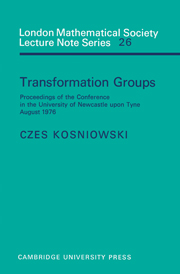 Transformation Groups
Transformation Groups Book contents
- Frontmatter
- Contents
- PREFACE
- PART ONE
- Generators and relations for groups of homeomorphisms
- Affine embeddings of real Lie groups
- Equivariant differential operators of a Lie group
- Equivariant regular neighbourhoods
- Characteristic numbers and equivariant spin cobordism
- Equivariant K-theory and cyclic subgroups
- ℤ/p manifolds with low dimensional fixed point set
- Gaps in the relative degree of symmetry
- Characters do not lie
- Actions of Z/2n on S3
- Periodic homeomorphisms on non-compact 3 manifolds
- Equivariant function spaces and equivariant stable homotopy theory
- A property of a characteristic class of an orbit foliation
- Orbit structure for Lie group actions on higher cohomology projective spaces
- On the existence of group actions on certain manifolds
- PART TWO (SUMMARIES AND SURVEYS)
Orbit structure for Lie group actions on higher cohomology projective spaces
Published online by Cambridge University Press: 05 March 2012
- Frontmatter
- Contents
- PREFACE
- PART ONE
- Generators and relations for groups of homeomorphisms
- Affine embeddings of real Lie groups
- Equivariant differential operators of a Lie group
- Equivariant regular neighbourhoods
- Characteristic numbers and equivariant spin cobordism
- Equivariant K-theory and cyclic subgroups
- ℤ/p manifolds with low dimensional fixed point set
- Gaps in the relative degree of symmetry
- Characters do not lie
- Actions of Z/2n on S3
- Periodic homeomorphisms on non-compact 3 manifolds
- Equivariant function spaces and equivariant stable homotopy theory
- A property of a characteristic class of an orbit foliation
- Orbit structure for Lie group actions on higher cohomology projective spaces
- On the existence of group actions on certain manifolds
- PART TWO (SUMMARIES AND SURVEYS)
Summary
INTRODUCTION
In this paper we describe the cohomological orbit structure of Lie group actions on cohomology projective spaces and show that under quite general conditions an arbitrary action has the same structure as that obtained from an equivariant James' reduced product construction applied to an action of the group on a sphere. Here X is a cohomology projective space if X ∼ Pn(q), i.e. H*(X) = Q[e]/(en+1) as a Q-algebra, where deg e = q is even. Cohomology is always taken with rational coefficients. If q = 2, X is a cohomology complex projective space and if q = 4, X is a cohomology quaternionic projective space. For those cases linear actions on the classical projective spaces demonstrate that tori of large rank can have rich orbit structures (e.g. many non-acyclic components of the fixed point set). The work of Wu Yi Hsiang and Hsiang and Su shows that the cohomogical orbit structure of an arbitrary action is modelled after the linear examples in general. In particular, there is the following theorem of Hsiang and Su: If X ∼ Pn(4) and a torus of rank at least two acts cohomology effectively on X, then at most one component of the fixed point set is a pr(4) with r > O.
Our work is concerned with the higher cohomology projective spaces, i.e. q > 4.
- Type
- Chapter
- Information
- Transformation GroupsProceedings of the Conference in the University of Newcastle upon Tyne, August 1976, pp. 204 - 225Publisher: Cambridge University PressPrint publication year: 1977
